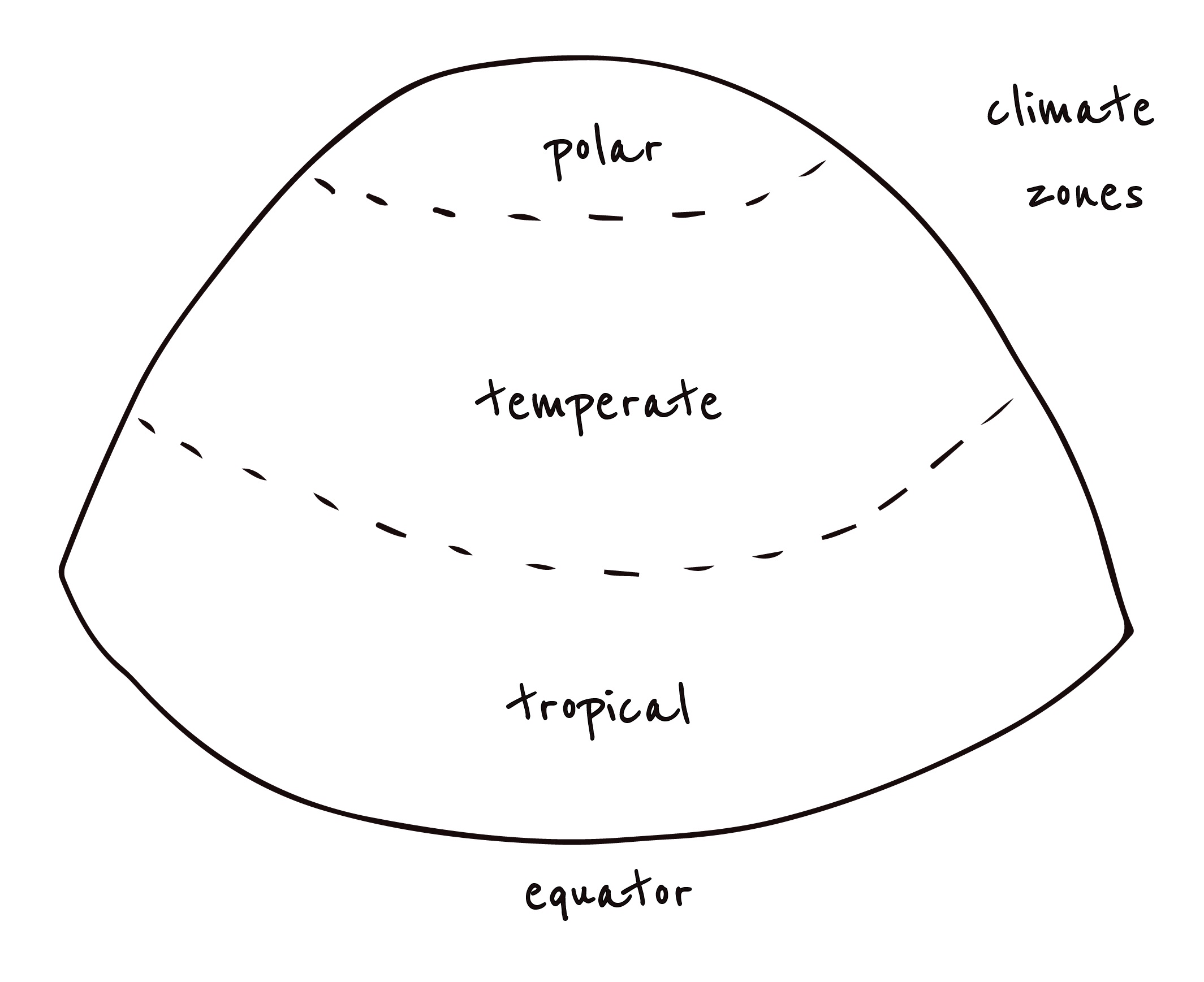
Temperate climatic zones are the regions that lie at the edge of the tropical (24 deg N/S) and polar (66 deg N/S) regions of our planet. Because of the earth´s tilt on its axis, the temperates are characterized by distinct seasons and lower sun paths. For agriculture, temperates are both exciting and challenging. While the pronounced seasons, in some cases extreme, offer opportunities for diversity in vegetation and a seasonal cycle of creation and consolidation, they may also require different farming strategies and kinds of crops for different seasons of the year. Temperate regions, globally, are highly productive farming areas mainly because of cereal crops and have growing potential and possibilities with changing climate and land use patterns in India and the world.
Our experience of farming from 2014 to 2019 has been in the mountains of the tropical montane/highland (Kodaiakanal: 10 deg N, 1800 m alt, 1700 mm avg. rainfall) and sub-tropical-temperate (Bir: 32 deg N, 1800 m alt, 2000 mm avg. rainfall) regions of India. The topographical and thermal gradients of a mountain landscape present possibilities for development and nurturing of varied vegetation, animals and human cultures.
Interestingly, Nikolay Vavilov, the Botanist and explorer from Russia, considered mountains as the centers of origin for domesticated agriculture crops, the hotspots where all our food that we eat today comes from.
The edges of the mountains superimposed on the edges of a temperate climate create a complex ecology with an immense richness of life. Modern agriculture and lifestyle, however, have narrowed the spectrum of human diet, cultivated and wild foods, and the diversity of the forests and the farmlands. The following are some of our observations and practices that we experimented with during this time and might be useful to a farm on the path of regenerative agriculture in the temperate and mountain areas of India.
SOIL
Temperate soils are slow forming soils and generally have deep topsoil layer. The richest soils in the world are in the cold temperate forests with deciduous trees due to large amount of leaves falling on the soil in autumn and their slow decomposition in winter (in tropical warm humid climates where the soils form quickly are also lost and depleted quickly with erosion and leaching.) However, temperate mountains lose a lot of topsoil due to erosion especially on agricultural lands where vegetation is not perennial and land is ploughed for one season and often left fallow for the following one. Terracing on mountain lands prevents erosion and, if designed well, can help to retain heat from the sun (the vertical edge) and hold and infiltrate water from the rains (the slope).
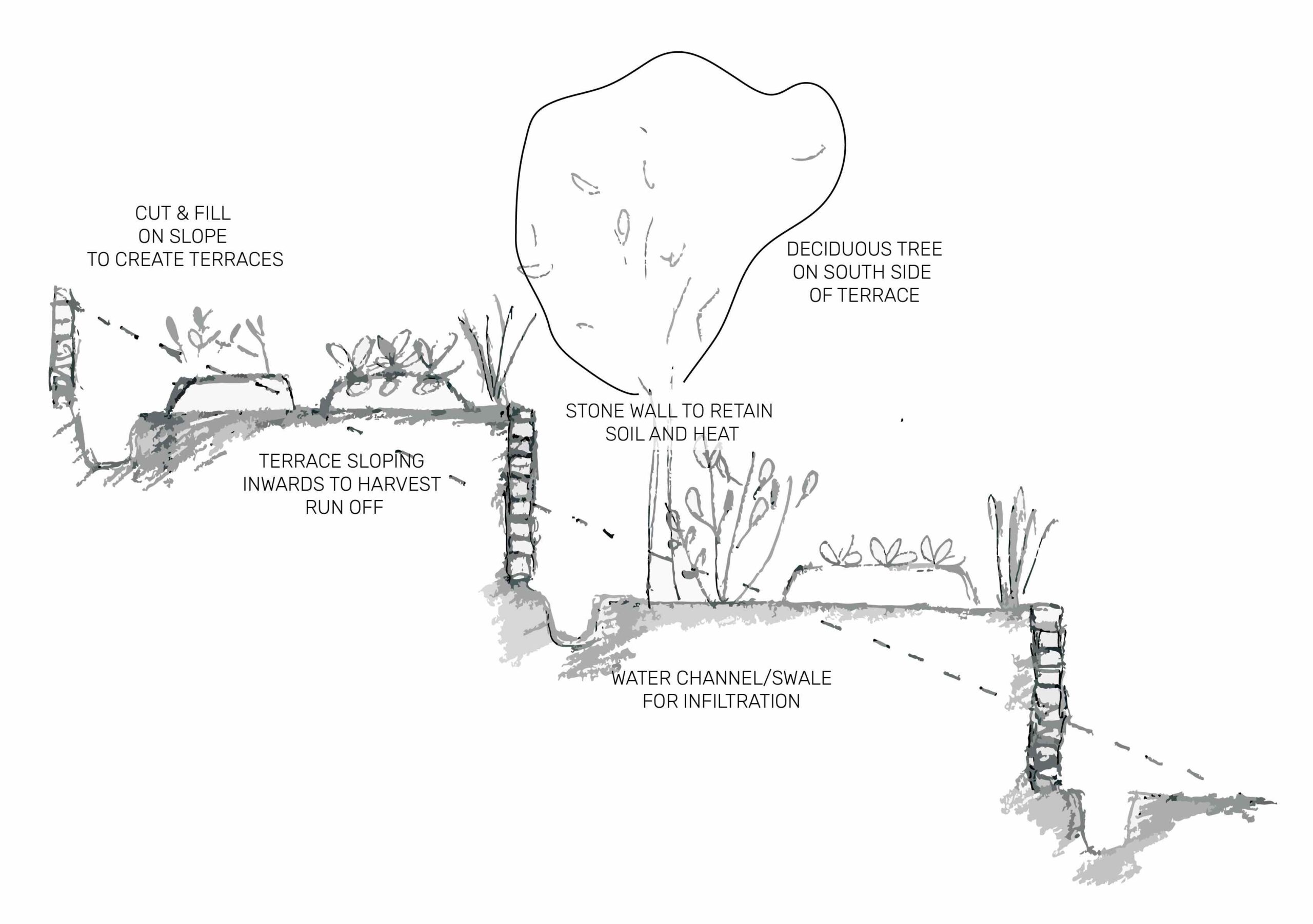
Strategies for soil work:
- Fast growing trees and shrubs for biomass
The foundation for soil work is adding organic matter to the soil to feed the life in it. In temperate zones, plants grow slowly and therefore a farm needs to have sufficient trees and plants that can generate enough biomass to be added to the soil throughout the year.
Some of these plants that we have found to be effective in Bir are:
| PLANTS | LOCAL NAME | BOTANICAL NAME | DECIDUOUS / EVERGREEN | PRUNING HABIT |
| WHITE WILLOW | Beyuns | Salix alba | D | Pollard in winter |
| WEEPING WILLOW | Beyuns | Salix babylonica | D | Pollard in winter |
| BEUL / BHIMAL | Beul | Grewia optiva | D | Pollard in winter |
| MULBERRY WHITE | Toot | Morus alba | D | Pollard in winter |
| ORCHID TREE | Kachnaar | Bauhinia variegata | D | Pollard in winter |
| NEPAL ALDER | Unis | Alnus nepalensis | D | Pollard in winter |
| NETTLE TREE | Khirk | Celtis australis | D | Pollard in winter |
| BANANA | Kela | Musa | E | Coppice after fruiting or in autumn |
| BLACK ELDERBERRY | Kali beri | Sambucus Nigra | D | Prune back in winter |
| STINGING NETTLE | Aen | Urtica dioica | E | Coppice in winter |
Besides these there are several trees like Quercus leucotrichophora (Oak) and Machilus odoratissima (Bhadrol) that provide large amounts of biomass through their thick foliage that sheds itself every winter, but they take a long time to grow. The plants listed above are all native species.
There are also fast growing grasses like the tall fescue which is popular in the region of Bir as a cow grass. Such grasses are good for mulching or could even be exchanged with local farmers for cowdung or dry biomass. Other potential plants that we think have potential in this regard are Castor (it grows naturally along roadsides and where the soil is dug to make bridges etc.) and Black locust (Robinia Pseudoacacia) which can also be seen in the recently afforested areas managed by the local Forest Department.
The foreign pioneer species can initially be used to generate biomass and feed and recuperate the soil and can be replaced completely in 3-6 years with native deciduous and evergreen tree species. While choosing native or foreign species, in our experience, it is better to create an integrated plan where both natives and new species can exist and have their role. This creates diversity and possibilities for the changing ecological and social systems.
- Raised beds
Though raised beds are not unique to temperate climates anymore, their usefulness in warming the soil faster during the day and draining off excess moisture make them ideal for cold climates especially in high precipitation areas. The beds are raised with soil from the adjacent pathways which also serve to channel water during monsoon thereby preventing water logging. The following are some of advantages of raised beds irrespective of the context.
- Clear human circulation prevents stepping on beds and compaction
- No tilling or digging required
- Beds designed for ease of working and access
- Buiding soil over the bed is easier
In India, raised beds are commonly used for vegetable cropping but they are becoming more and more popular also for tree orchards and even cereal and grains. The height of the raised beds is typically around 20-30 cm. Erosion occurs over time, reducing the height and damaging the edges of the bed and thus require some maintenance every couple of years depending on the amount of rainfall and the method of irrigation. The best time to reshape the beds is in spring and autumn. While doing this, it is important to check the slopes of the pathways to get a good flow of water in the direction desired.
The orientation of the beds is based on:
- Sun path/shade: Orienting the beds in a way that sun exposure is optimised
- Slope of the land: Beds made across the slope of the land hold water in the channels and facilitate infiltration.
- Shape of the terrace (on terraced lands): Beds shaped along the terrace minimise the walking distance to access the beds.

- Using edges for grasses and chop and drop plants
Sunlight in temperate areas is a valuable resource and the farm should make the most of it by dense vegetation capturing most of the sunlight falling on the land. The edges of the terraces and the farm boundaries and other places on the farm that are not used for cultivating crops must be planted with wild shrubs, flowers, grasses etc. to be cut back during monsoon and winter to provide food for animals and the soil.
- Composting for accelerating decomposition
Because most of the growth happens in summer and monsoon season, the time to prune and harvest biomass is winter. At the end of winter, there is so much biomass that it may be difficult to add it to the soil directly. Also, the mulching in spring needs to be lighter to allow the Sun to warm the cold winter soil. Therefore, the biomass from winter can be used to make good quality compost that can feed the soil throughout the year, rather than leaving the biomass to dry out in the open and lose its energy to oxidation and leaching.
Composts can be made according to the soil biology required to grow particular crops. For example, high fungal composts for trees and orchards, a fungal-bacterial balance for grains and cereals and bacterial dominated compost for annual crops.
Compost also helps to accelerate the natural decomposition process and can make the nutrients and biology available to the soil in a balanced and natural way.
The two most efficient composting methods for cold areas are thermal composting and vermicomposting. In thermal composts, heat is generated by bacteria as they thrive on a Nitrogen rich food in the compost which accelerates the otherwise slow decomposition process. Any fresh animal dung can be used as high Nitrogen food source. Vermicomposting is a cold composting process and the worms thrive in cool and wet environment transforming organic matter into rich compost up to five times their weight every day. Read more on thermal composting and vermicomposting here.
- Banana circles
A banana circle is basically a pit with a raised edge which can be used for planting, and is a common method in the tropical areas for growing bananas around the pit for biomass and/or to treat greywater. This strategy can be adapted to the temperates both in dry and wet conditions. There are many mountain varieties of Banana that thrive in the cold climates. Other plants that go well in a banana circle are Cape-gooseberries, Collards and Kale, Taro, Strawberries, Lemongrass and Mint etc. The pit collects moisture from dew and rain and creates a rich habitat for worms and microbes and becomes a composting unit in itself. This feeds the plants growing on the edge. This is a great way of creating self-sustaining vermicompost pits across the farm. Also, biomass that is hard to deal with for compost or as mulch, like thorny bushes, seeded grasses etc. can be put in the pits and recycle them into bananas and other plants that give food and can later be used for compost and mulch.

- Cycles for composting and mulching
The temperate seasons mark a different rhythm of life in each season. There is growth and activity in the spring-summer time and rest and consolidation in the autumn-winter time. This pattern reflects in behaviors across vegetation, animals and humans.
| SPRING | SUMMER | AUTUMN | WINTER | |
| Mulching | Light mulch to allow spring sun to warm the winter soil | Heavy mulch to prevent evaporation and preparing soil before monsoon | Light mulch in water saturated soils. Heavy mulch to prepare for winter. | Heavy mulch to protect soils from the cold. |
| Compost | Apply compost | Make compost from all the biomass left after mulching | Apply compost | Make compost from all the biomass left after mulching |

PLANTS
Apart from the differences in crops for different seasons, one of the most fascinating aspects of changing seasons is the behavior of trees. One of the ways of classifying trees is evergreens and deciduous. Deciduous trees are the trees that lose their leaves in a particular season to avoid loss of water, conserve energy and reduce resistance to extremely hot/cold winds. The trees that lose their leaves before summer are called summer deciduous and are mostly found in warmer climates with extremely dry summers. The trees that shed their leaves before winter are called winter deciduous and are mostly found in colder climates. They regrow their leaves once the extreme season has passed. In the case of Evergreen trees, old leaves fall and new leaves appear throughout the year and thus they are green irrespective of the season.
Deciduous trees generally have higher growth rates and shorter life spans as compared to evergreen trees. Most of the fast growing pioneer tree species are of deciduous habit. Deciduous trees provide shade in summer and lose all their leaves in winter to allow the lower Sun to pass through. This habit can be used interestingly to create microclimates for houses and crops. Also deciduous trees create a lot of biomass in autumn/winter as they shed their leaves. Some of the fast growing species can also be cut down in winter to provide biomass for soil or for fuel, to grow back again the following season. Such trees can be densely planted between young fruit and on the edges of the terraces.
While planting, the path of the sun must be considered and the tall plants and trees must be planted to the north of the shorter plants in the northern hemisphere and to the south of the shorter plants in the southern hemisphere. By integrating evergreens and deciduous trees and combining with different shrubs, herbs and crops, it is possible to create food forest with at least seven layers of vegetation. The list of plants growing at Shunya farm classified by their strata of growth is given in this list:
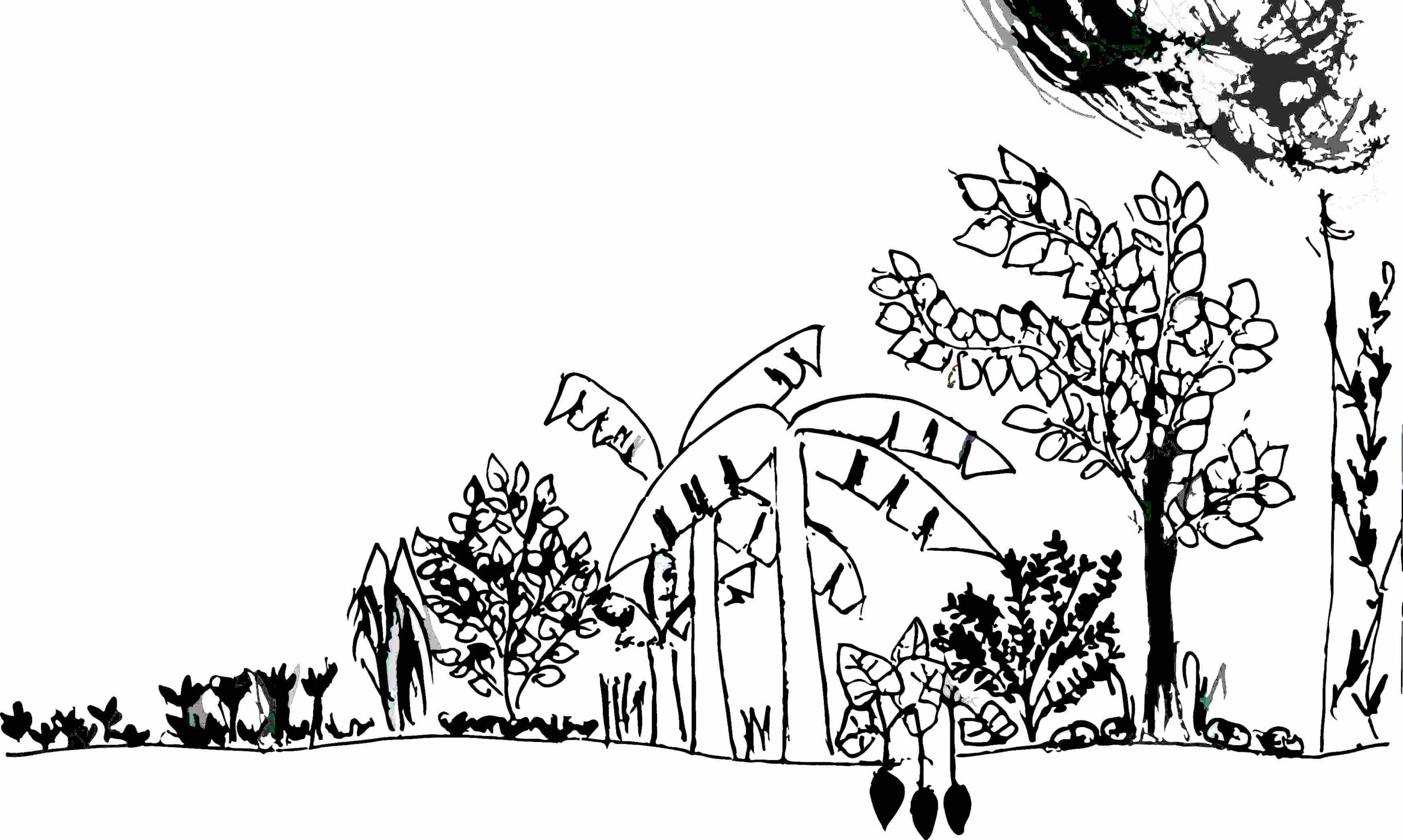
FARMING
Many studies consider the temperate regions to be the birthplace of farming. The distinct seasons and good deep soils set a perfect template for farming. However, the shift in farming paradigms leading us towards agroforestry and food forests require changes also in the way we are used to thinking about the Sun and the soil.
Strategies:
- Following the sun
As described earlier, deciduous trees can be strategically used to shade out places in the summer and allow sun to pass through in the winters. They also help in producing mulch in the form of fallen leaves.
Such trees are great also on the edge of terraces. When the sun is higher in the sky in summers, the trees will not shade the crops growing to the north of the trees, when the sun is lower in the sky in winters, the bare trees will allow the sun to pass through. e.g. Mulberry, Plum, Peaches, Cherry, Apple etc. Similarly when inter-planting different crops in the same bed/area, the taller crop planted on the north side will allow sun for the shorter crop to the south.
This is the planting schedule for Bir, Himachal Pradesh, India:

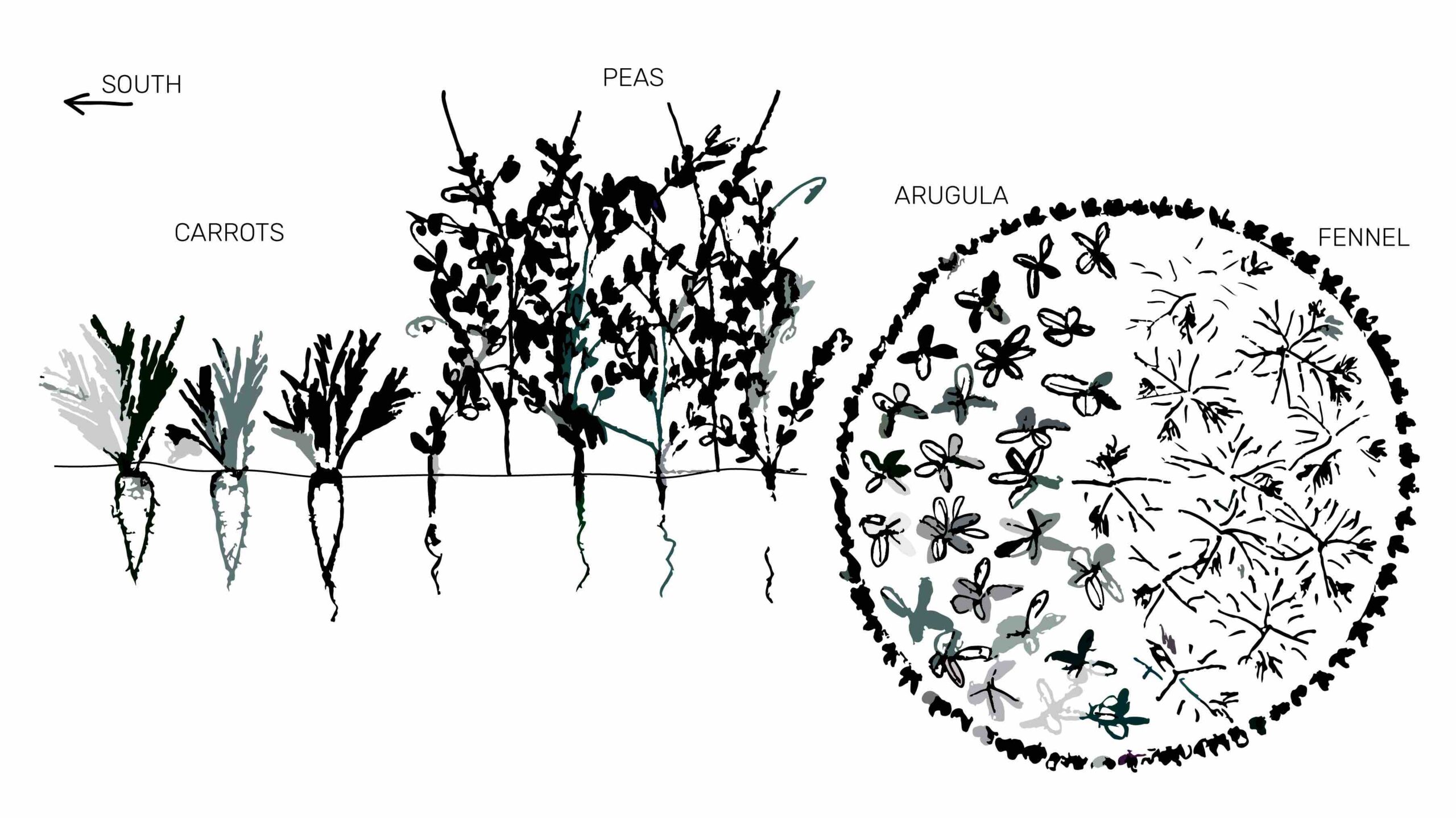
- Sun trap
Sun trap is a place that receives sun and is sheltered from winds. In our case, this means that the area is open on the South to let sun through and covered with trees in the North side to protect the area from cold winds. Sun traps create a microclimate and benefit both tree and vegetable crops by reducing the stress from cold strong winds and by optimizing the sun exposure to all plants. In a typical Sun trap design, the trees on the north, curving to both east and west directions, are often of evergreen habit to ensure a dense windbreak during winter and there could be trees of the deciduous habit on the south side to protect the area from summer sun and allow sun in winters.
We have tried this on a very small scale without evergreen trees on the north. We planted trees of varying heights on the north side and even though some of them lost their leaves, their structure still protected the shorter plants to the south from northern cold winds.
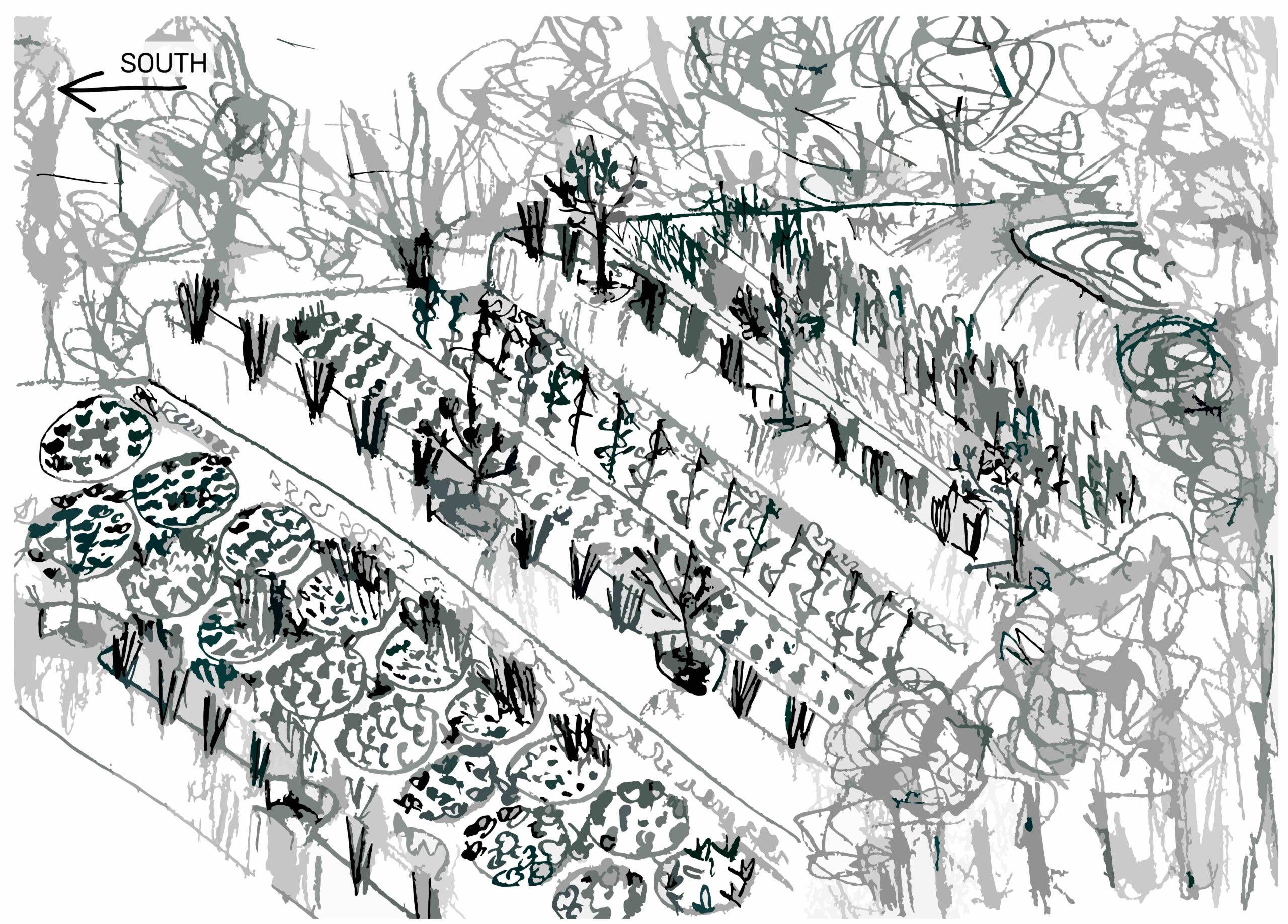
- Greenhouse
Greenhouses are being used across the world at varying scales of sizes and technology to control the growing conditions. A greenhouse is a structure made out of a transparent material like glass or plastic to retain heat inside. Greenhouses are used to create warm growing conditions in extremely cold climates and in some cases desired climatic conditions with the help of temperature and humidity control.
In temperate farming, greenhouses help to extend growing seasons and cultivate some specialty crops that are otherwise difficult to grow in the temperates. They also offer protection to plants from birds, hailstorms, strong winds etc. As the temperature inside the greenhouse can be really hot, it needs good ventilation and requires irrigation almost every day to maintain soil moisture. In effect a greenhouse mimics a tropical wet ecosystem climate.
The greenhouse on Shunya farm is a small structure for experiments in a controlled environment on diverse crops and their behavior with change in season and temperature. The greenhouse also helps in starting seeds before spring to obtain an early crop. This is important for a market farm as continuing harvests have to be maintained in all seasons. As inside, the greenhouse also creates a microclimate on the outside radiating the heat slowly in all directions. The area outside the greenhouse is being used to grow fruit crops like Banana and Litchi which normally require a warmer climate. The diversity within the greenhouse helps in preventing pests and diseases which is a common problem in most greenhouses. Besides the experiments with different crops, we used the green house for learning how temperature affects germination, growth and plant life cycles.
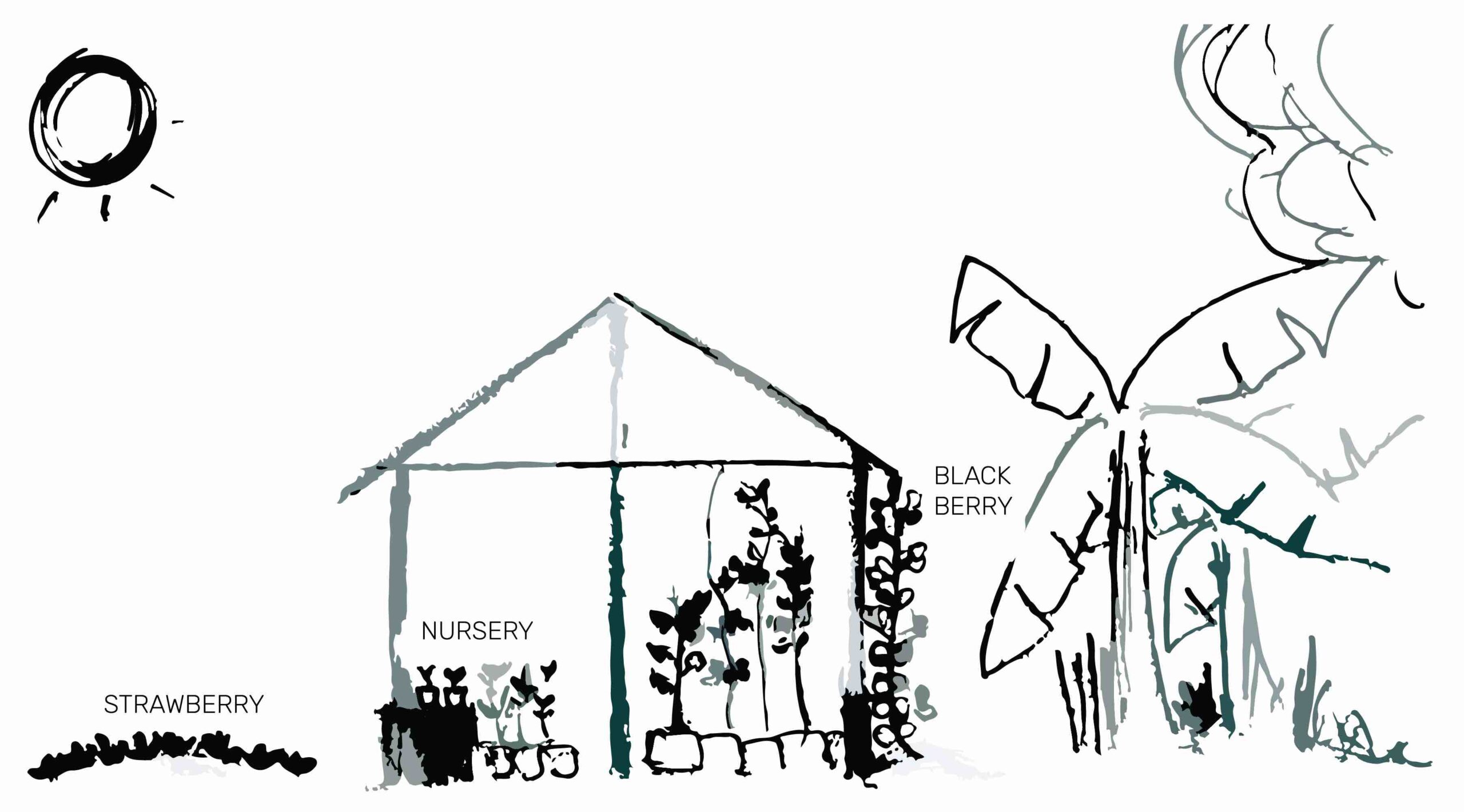
- Successional Agroforestry
Successional Agroforestry is a process based farming mixing perennials with annual crops over time. It has three important aspects:
- Densely planting fast-growing pioneer trees to initiate the succession.
- Systematic pruning, coppicing of trees, weeding, chopping to add biomass to the soil which will add to soil carbon, cover the soil from the sun, water and wind erosion and feed the soil life.
- Selectively felling off trees to create gaps for planting late successional species, fruit trees, and other beneficial plants.
We started studying this process and experimenting with it in 2017. We created a succession plan for some parts of the farm for three years. We were still learning about different species, introducing new ones and observing their success and hence the plan has gaps and many more plants can be added to it. The template for this already exists on the farm and we should be able to see some exciting results in a few years.
This is the three year plan for successional planting for Bir, Himachal Pradesh, India: https://docs.google.com/spreadsheets/d/1gQq9gDk77RVWZ3MWeBNaHu0O5-cGfqryzZJQuTEB9SE/edit#gid=1959157578
This is an interesting strategy anywhere (it was developed in Brazil) but especially for temperate areas it offers many opportunities for integrating different tree species, of different habits, and accelerates the soil succession which is otherwise slower compared to the tropics.
ANIMALS
Farming in India is always associated with animals but even more so in the temperate cold regions. Here the families depend on the animals not only for dung, labour and milk/eggs but also for their meat. Traditionally the animals have been a source of food for communities in the mountains to compensate for the limited plant based food due to short growing seasons. Animals have also been integrated within human habitats examples of which can be seen in the traditional houses in cold regions and mountains of India where big animals on the lower level provide warmth for smaller animals living with them and for humans on the upper level of the house.
In Bir, the most common domesticated animals are cows, sheep, goats, rabbits and chickens.
As communities become more and more fragmented, care for animals on community and even family levels has become a challenge, particularly for large animals like cows. There are many other questions around the ethics of animal care, their role in agriculture, natives and hybrids, and they require a good understanding of the context and the animals to be able to introduce them on a farm. With increasing awareness around exploitation of animals for their products, new farmers are either adopting practices based on care for animals in agriculture or choosing completely to forgo having any domesticated animals on the farm. However, animals have been an important and indispensable part of the human and agri- cultures. Their presence adds complexity and richness to the relationships between the land, humans and food.
In Bir, we decided not to have a cow or goats on the farm because of the following reasons:
- A cow either requires a pasture land for grazing or food needs to be cut and brought to the cow every day. Taking the cow to graze in the forest or cutting and bringing food for it is a time consuming task and was not feasible for a three member team involved all day on the farm. Goats too need to be taken out to graze in the forest every day.
- The products from a cow/goat, milk and dung are easily and abundantly available in the village and thus keeping your own cow/goat has little motivation.
- Limitation of space on the farm, and limitation of funds to invest in a pen for cows or goats.
Chickens, however eat scraps from the kitchen and the farm, have much smaller footprint and are easy to keep. There were also not too many ‘free range’ desi (country) chickens in the village and we saw eggs from these chickens as a healthy addition to harvests of the farm. This encouraged us to bring a young flock of 4 chickens on the farm. The bedding from the chicken coop of straw from wheat and corn mixed with nitrogen rich chicken manure was a great addition to the farm compost. There are also ways of allowing chickens into the fields after a harvest to let them peck at the weeds and bugs. We never tried it because the chickens were still quite small and also that on a small intensive farm a strong protection to the ongoing crops would be required. Besides the obvious products, the chickens added happiness and liveliness to the farm and a new layer of learning and ecosystem relationship making the entire place and the work around it richer.
The decision to introduce domesticated animals on a farm would therefore depend on the land and human resources to care for the animals and finding the most appropriate breeds to honor the heritage of the land and the culture.
FOOD
It is also important to value the local edible food and learning to store and preserve the cultivated foods for winter months when the vegetative growth is limited.
Pickling, fermentation, drying and making jams are great ways of increasing the life of vegetables and fruits.
More details: https://shunya.earth/preserves/
Some common edible wild plants in the region:
Wild Buckwheat / Phaphroo
Wild Amaranth / Chaulai
Fiddlehead Fern / Lungdu
Himalayan Raspberry / Aakhey
Stinging Nettle / Aen
Pigweed / Bathua
Wood Sorrel / Khatta
Watercress / Chhooch
Purslane / Kulfa
–
Besides the ones mentioned above, there are many other methods and techniques that were used on the farm but they are not temperate specific e.g. strategies for water management will primarily depend on the amount of precipitation and the kind of soil. There are many new farming initiatives within the temperate regions of India and particularly in the mountains of North India. With Sikkim already committing to complete organic farming and Himachal Pradesh working its way to do the same in the future, there is need for temperate specific experiences and visions to help with this transition. Private projects, support from farmer collectives and the government could help rediscover the resilience of the traditional farming communities in these regions by experimenting with techniques, such as those described above, based deeply on the patterns of Nature with potential to turn challenges into opportunities for healthy humans, soil, plants, animals, and ecosystems.
